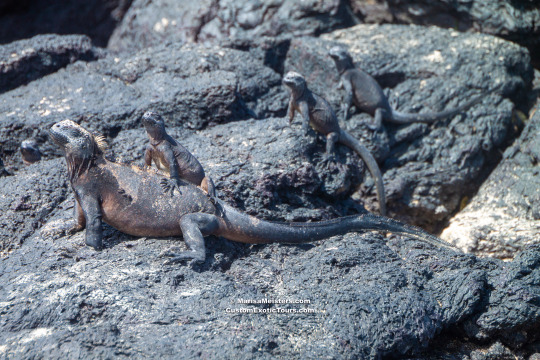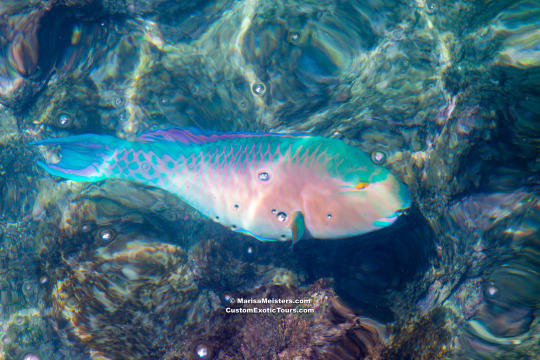#unusualwildlife
Text
Introduction to the Galapagos Islands, Ecuador
This week's travel inspiration takes us to the Galapagos Islands! Have you ever wanted to travel to a place where wildlife does not have much fear of humans? Where you can see species that exist nowhere else on earth? Where plants and animals have adapted over thousands of years, such that there are even species differences between individual islands? If you answered yes to any or all of these questions, then the Galapagos Islands is a great place to put on your bucket list!

Crystal clear waters in the Galapagos Islands
The Galapagos Islands are located about 600 miles from mainland Ecuador in northern South America (in fact, one of the islands crosses the equator), and they are part of the country of Ecuador. This is where Charles Darwin came up with his theory of Evolution in the 1800s, when he saw differences in the same animal species between the islands.

Marine iguanas sunbathing in the Galapagos Islands
Some of the most common animals you'll see include marine iguanas, other lizards, sea lions, many birds, turtles and tortoises. If you're into snorkeling and/or diving, you'll have a chance to see an amazing and colorful variety of fish as well.

Blue-Chin Parrot Fish in the shallow Galapagos waters
You can visit the Galapagos Islands as part of a cruise between islands, or by making your home base on one of the islands and traveling to other islands from there. The options are limitless. The more time you have to spend here, the more you can explore on your own time.
I'll give you more Galapagos information coming up in a few more weeks; there's just too much to pack into one email. Hopefully this information is enough to get you interested in seeing all that the Galapagos Islands can deliver.

Until next week,
Marisa
#Galapagos#GalapagosIslands#travelwithus#travel#cruise#Galapagoscruise#parrotfish#photography#Ecuador#wildlifetour#wildlife#unusualwildlife#bluechinparrotfish
1 note
·
View note
Video
Lesser Known Animals —- Meet The Aardwolf The video shows cubs at the den, foraging at night and during the day as well as still images of a cub and an adult. “The aardwolf (Proteles cristata) is a small, insectivorous mammal, native to East and Southern Africa. Its name means "earth-wolf" in Afrikaans and Dutch. It is also called "maanhaar-jackal" (Afrikaans for "mane-jackal"),"ant hyena" or civet hyena, based on its habit of secreting substances from its anal gland, a characteristic shared with the African civet. The aardwolf is in the same family as the hyena. Unlike many of its relatives in the order Carnivora, the aardwolf does not hunt large animals. It eats insects and their larvae, mainly termites; one aardwolf can lap up as many as 250,000 termites during a single night using its long, sticky tongue. The aardwolf lives in the shrublands of eastern and southern Africa – open lands covered with stunted trees and shrubs. It is nocturnal, resting in burrows during the day and emerging at night to seek food.” - Wikipedia Video compiled by me from various sources including: Gecko Creek Wilderness Lodge, Wikimedia Commons, Alfie Curling, Twitter user @Orca_Mandaeru and Richard Broadley. images and video was gathered for fair educational use. #Aardwolf #AardwolfVideo #UnusualWildlife #AfricanWildlife #Insectavore https://www.instagram.com/p/BxUCUjxgauH/?igshid=1mpw23alish1h
1 note
·
View note
Photo

Amazing what you find lurking under benches down in the woods. #downinthewoods #downinthewoodstoday #unicorn #thingsyounoticeduringlockdown #morningwalk #urbanmyth #urbanmythology #unusualwildlife #mythicalcreatures #unicornsofinstagram https://www.instagram.com/p/B_EW_GejZe1/?igshid=jvivounmni88
#downinthewoods#downinthewoodstoday#unicorn#thingsyounoticeduringlockdown#morningwalk#urbanmyth#urbanmythology#unusualwildlife#mythicalcreatures#unicornsofinstagram
0 notes
Photo

The world’s cutest animal face arguably belongs to the Quokka from Rottnest Island off The coast of Western Australia. Here we have a couple photos and several videos. To view them all swipe from left to right. • • • This is a #repost @heatherfeather43 via @PhotoAroundApp On one of the videos A Quokka rifles through her bag!!!!!!!!! 🤣🤣🤣🤣 all the other videos came from various tweets. - - - - #quokka #perth #australia #perthaustralia #rottnest #rottnestisland #neverstopexploring #unusualanimals #UnusualWildlife #unusualanimalfriends
#neverstopexploring#australia#unusualanimalfriends#unusualanimals#rottnestisland#repost#perth#unusualwildlife#rottnest#quokka#perthaustralia
1 note
·
View note
Photo

Aye Yi Yi! It’s an Aye-Aye an unusual lemur from Madagascar. With its skinny, boney finger it can tap wood listening for sounds the pull out a grub to eat. • • • This is a #repost @naturalworldsafaris via @PhotoAroundApp The aye-aye of #Madagascar is one the most unusual animals in the world! This one was photographed by @shannon__wild #MyMadagascar #UnusualWildlife #AyeAye #AyeAyeLemur #Lemurs #StrangeAnimals
1 note
·
View note
Video
Lesser Known Animals —- Meet The Maned Wolf Video compiled by me. “The maned wolf (Chrysocyon brachyurus) is the largest canid of South America. Its markings resemble those of foxes, but it is neither a fox nor a wolf. It is the only species in the genus Chrysocyon (meaning "golden dog"). This mammal is found in open and semiopen habitats, especially grasslands with scattered bushes and trees, in south, central-west, and southeastern Brazil, Paraguay, northern Argentina, Bolivia east and north of the Andes, and far southeastern Peru (Pampas del Heath only). It is very rare in Uruguay, possibly being displaced completely through loss of habitat. The International Union for Conservation of Nature lists it as near threatened, while it is considered a vulnerable species by the Brazilian Institute of Environment and Renewable Natural Resources. It is known locally as aguará guazú (meaning "large fox" in the Guarani language), or kalak in the Toba Qom language, lobo de crin, lobo de los esteros, or lobo colorado, and lobo-guará in Brazil. It also is called borochi in Bolivia.” - Wikipedia Credit: images and video was gathered for fair educational use from World Land Trust, Wikimedia Commons and Jones Bender Reisner. #ManedWolf #UnusualWildlife #SouthAmericanWildlife #ManedWolfVideo #LesserKnownAnimals https://www.instagram.com/p/BxUF100A8d6/?igshid=1p9yyplor9oqk
0 notes
Video
This cute and unusual mammal is a Yellow-Spotted Hyrax. • • • This is a #repost from @zoogirlsd via @PhotoAroundApp Snack time with the adorable Yellow-Spotted Hyrax, also known as the Bush Hyrax. Believe it or not, these guys are some of the closest living relatives of elephants! #nomnomnom #yellowspottedhyrax #bushhyrax #hyrax #cuteanimals #unusualanimals #UnusualWildlife #animalvideo #zooportraits #zoophotography #sandiegozoo
#nomnomnom#zooportraits#yellowspottedhyrax#bushhyrax#unusualanimals#animalvideo#cuteanimals#unusualwildlife#zoophotography#hyrax#sandiegozoo#repost
0 notes
Photo

This rather creepy creature is a Burmese Peacock Softshell Turtle • • • This is a #repost from @annie_reb via @PhotoAroundApp 😯This is a Burmese Peacock Softshell Turtle 🐢. Freaks me out a little and is pretty cool—I mean come on, its nose is a snorkel. Repost @natgeo @joelsartore video by Joel Satore #turtle #turtlesofinstagram #amphibian #amphibiansofinstagram #nationalgeographic #joelsatore #photoark #photography #animalphotography #animals #UnusualWildlife #unusualanimals
#joelsatore#amphibiansofinstagram#photography#turtlesofinstagram#unusualanimals#photoark#unusualwildlife#turtle#repost#nationalgeographic#animalphotography#animals#amphibian
0 notes
Photo

Z is for Zebroid. “A zebroid (also zedonk, zorse, zebra mule, zonkey, and zebmule) is the offspring of any cross between a zebra and any other equine: essentially, a zebra hybrid. In most cases, the sire is a zebra stallion. Offspring of a donkey sire and zebra dam, called a zebra hinny, or donkra, do exist but are rare and are usually sterile and infertile. Zebroids have been bred since the 19th century. Charles Darwin noted several zebra hybrids in his works.” - Wikipedia. • • • #Zebroid #ZebraHorseCross #ZebraEquineCross #UnusualWildlife #UnusualAnimals
0 notes
Video
Fallow Deer, including a White Stag, In Great Britain 🇬🇧. • • • This is a #repost from @charlottesamsphotography via @PhotoAroundApp A rather lovely fallow deer having a scratch, followed by a wonderful sighting of a white stag! Not an albino or a mystical creature, this colouration is caused by leucism, a reduction in skin/hair pigment. @bbcspringwatch @femalenaturephotography @bbcearth @natgeoyourshot #FallowDeer #WhiteStag #UnusualWildlife #UnusualAnimals
0 notes